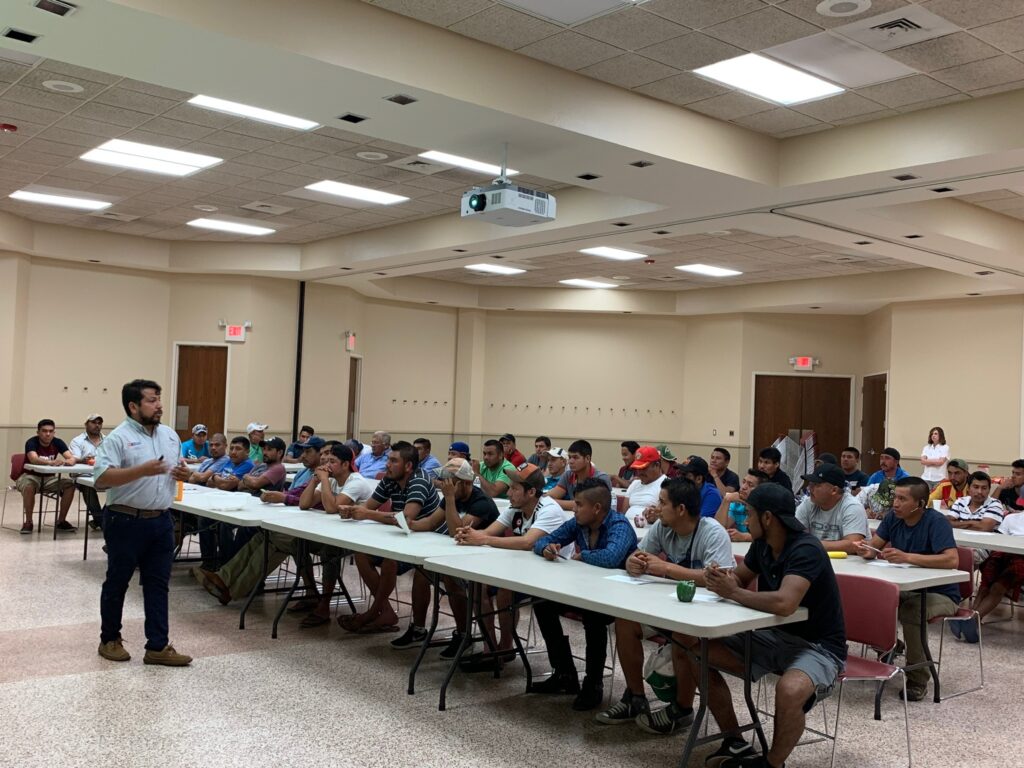Agricultural Workforce Health and Safety Education Program
go.ncsu.edu/readext?1049612
en Español / em Português
El inglés es el idioma de control de esta página. En la medida en que haya algún conflicto entre la traducción al inglés y la traducción, el inglés prevalece.
Al hacer clic en el enlace de traducción se activa un servicio de traducción gratuito para convertir la página al español. Al igual que con cualquier traducción por Internet, la conversión no es sensible al contexto y puede que no traduzca el texto en su significado original. NC State Extension no garantiza la exactitud del texto traducido. Por favor, tenga en cuenta que algunas aplicaciones y/o servicios pueden no funcionar como se espera cuando se traducen.
Português
Inglês é o idioma de controle desta página. Na medida que haja algum conflito entre o texto original em Inglês e a tradução, o Inglês prevalece.
Ao clicar no link de tradução, um serviço gratuito de tradução será ativado para converter a página para o Português. Como em qualquer tradução pela internet, a conversão não é sensivel ao contexto e pode não ocorrer a tradução para o significado orginal. O serviço de Extensão da Carolina do Norte (NC State Extension) não garante a exatidão do texto traduzido. Por favor, observe que algumas funções ou serviços podem não funcionar como esperado após a tradução.
English
English is the controlling language of this page. To the extent there is any conflict between the English text and the translation, English controls.
Clicking on the translation link activates a free translation service to convert the page to Spanish. As with any Internet translation, the conversion is not context-sensitive and may not translate the text to its original meaning. NC State Extension does not guarantee the accuracy of the translated text. Please note that some applications and/or services may not function as expected when translated.
Collapse ▲About
The NC State Extension Agricultural Workforce Health and Safety Program, part of NC State University’s Cooperative Extension under the Community and Rural Development sector, began in 2014 with grant funding. Its objectives include promoting preventive behaviors and improving health and safety within the agricultural community. Over time, the program has developed a regional model, expanding its services to 10 counties across North Carolina, addressing critical risks such as pesticide exposure and heat stress, to name a few farm hazards.
The agriculture community on the farm is composed of farmers, crew leaders/contractors, and farmworkers and their families. Together, they contribute to North Carolina’s $111 billion agricultural economy, constituting 17 percent of the state’s income from agriculture and agribusiness. The state is recognized as the country’s number one tobacco and sweet potato producer and the second in Christmas tree production. Farmworkers are crucial for the Ag production circle. The NC Department of Commerce estimated 76,076 migrant, seasonal, and H2A farmworkers during the 2024 peak season.
Consequently, building and strengthening relationships within the farming community and providing educational programs to promote preventive behaviors among farmers, farmworkers, and their families is crucial to improving the health and safety of the agriculture workforce.
About the Farm Work Community
Farmworkers in the United States play a vital role in maintaining the nation’s food supply. However, due to social determinants, the agriculture workforce is a vulnerable community. Financial struggles are a common issue in this community. According to the 2019–2020 National Agricultural Workers Survey (NAWS), the median personal income of farmworkers was between $20,000 and $24,999, while the median family income ranged from $25,000 to $29,999. These figures illustrate the economic hardships that many farmworker families endure. (Gold, p. iii, 2022)
Demographic data reveals that farmworkers in the U.S. are predominantly foreign-born, with 63% born in Mexico. (Gold, p. i, 2022) Spanish is the primary language for 62% of this population, and nearly all, 98%, report speaking it fluently. Reading proficiency in Spanish varies, with the majority able to read well, but smaller segments report lower literacy levels. These language dynamics highlight the importance of creating resources and programs that are culturally and linguistically relevant. (Gold, p. 13, 2022)
Healthcare access is another critical issue, as only 48% of farmworkers surveyed reported having health insurance. This lack of coverage leaves many unable to address medical needs, further exacerbating their vulnerability. (Gold, p. 45, 2022)
The challenges farmworkers face regarding economic stability, language, and healthcare coverage emphasize the need for targeted programs to support their health, safety, and well-being. By addressing these challenges, we can strengthen the foundation of our nation’s food systems and improve the lives of the individuals who sustain them.
In North Carolina, the agricultural workforce has undergone a significant transformation over the past two centuries, shifting from reliance on enslaved African labor to a predominantly Spanish-speaking workforce. During the 19th century, enslaved individuals formed the backbone of North Carolina’s agricultural economy, working primarily on tobacco, cotton, rice, and other cash crop plantations (Otto, J., 1989 p. 27-44). Following the abolition of slavery, tenant farming and sharecropping systems dominated the agricultural labor force, which was made up of poor white and African American farmers for a long time (Logan, R., 1967, p. 122). By the mid-20th century, mechanization began to drastically change how crops were harvested, but labor-intensive agriculture—such as tobacco, sweet potatoes, and Christmas trees—still demanded a human workforce. In recent decades, the demographic of farmworkers shifted dramatically due to immigration patterns and federal programs like the H-2A guest worker program. During the last 10 years (2014-2024), the overall number of farmworkers in the state has decreased (84,247 to 76,076), but the of H2A numbers have increased from 14,382 in 2014 to 27,461 in 2024. This transition may be attributed to migrant workers transitioning to jobs in other sectors, such as construction or hospitality. (Arcury, 2020, p. 254)
The shift to a predominantly Spanish-speaking agricultural workforce in North Carolina has brought unique challenges in delivering effective adult learning programs. Many farmworkers face challenges such as limited English proficiency, low literacy levels, and differing cultural norms, which can hinder their ability to engage with traditional training methods. Designing programs that are both linguistically and culturally relevant is essential to ensure farmworkers can access and understand critical health and safety information. The NC State Extension Agricultural Workforce Health and Safety Education Program was created to address these challenges. By tailoring education efforts to meet the specific needs of this workforce—through Spanish-language resources, visual aids, interactive teaching methods, and culturally sensitive content—the program aims to improve farmworkers’ well-being and foster safer, healthier working conditions in North Carolina’s agricultural industry.
Extension Agricultural Workforce Health and Safety Comprehensive Program Model
The program components and regional model were developed based on lessons learned and have proven to be the most cost-effective for program implementation. The Program components include:
- Agricultural Worker Health and Safety Training (on farm and multi-farm at Extension Center)
- Provide farmworkers with training on pesticide safety, heat stress, and green tobacco sickness, and any other occupational hazards as needed.
- The standard 90 training meets U.S. Tobacco Agriculture Practices and new EPA Workers Protection Standard training requirements;
- Farm Labor Contractors (FLCs) Training
- Build relationships and communication between FLCs and state/community agencies and programs. The objectives included assisting FLCs in learning about regulatory and non-regulatory information and procedures for their professional growth and the well-being of the ag community.
- Community Educational Events
- Educate agricultural worker’s families and community members on the importance of joint efforts to promote farm work health and safety.
- Network and Partnership Development
- Identify educational needs and opportunities for agricultural workers and their families to join efforts to support the Ag Community.
- Extension Cross Programming
- Connect agricultural workforce and their families with other Extension programs and support other Extension programs.
Additional components might be added or prioritized based on the funding source, given that new funding might have a core work area included in the existing program structure.
Program Timeline
In 2024, the program provided 109 on-farm training sessions to 4,314 agricultural workers. Seventy-two growers and 14 farm labor contractors were involved.
Participants completed a post-survey at the end of the training session; 1,458 completed surveys were collected, documenting a 97.4% overall comprehension. The breakdown by training topic includes the following percentages of correct responses: 97% Worker Protection Standards, 97% Heat Stress, and 98% Green Tobacco Illness. At the end of the agricultural season, 16 farmers and 6 Farm Labor Contractors completed a survey via email or in person to provide feedback. In general, the respondents stated that the program benefits their workers by letting them understand basic concepts to maintain health and safety on the farm and recognized as one of the main strengths of the program’s offerings—it’s presented in both English and Spanish, which allows all workers to fully engage.
References
Arcury, T. A., & Quandt, S. A. (Eds.). (2020). Latinx farmworkers in the eastern United States: Health, safety, and justice. Springer Nature.
Burton, A. W., & Telpov, I. B. (2008). Farm Labor: 21st Century Issues and Challenges. Nova Science Publishers.
Gold, A., Fung, W., Gabbard, S., & Carroll, D. (2022). Findings from the national agricultural workers survey (NAWS) 2019–2020: a demographic and employment profile of United States farmworkers. US Department of Labor, Employment Training Administration, Office of Policy Development Research, 3-5.
Hamilton Jr, J. V. (2004). The dynamics of labor in North Carolina’s Christmas tree industry. North Carolina State University.
Henderson, J., & Kauffman, N. (2013). The wealth effect in US agriculture. Main Street Economist, (1).
Immigration and Ethnic History Society. (n.d.). Immigration Reform and Control (IRCA) (1986). Retrieved from https://immigrationhistory.org/item/1986-immigration-reform-and-control-act/.
Lemann, N. (2011). The Promised Land: The Great Black Migration and How It Changed America (Helen Bernstein Book Award). Vintage.
Otto, J. (1989). The Southern Frontiers, 1607-1860: The Agricultural Evolution of the Colonial and Antebellum South. Bloomsbury Publishing USA.
Walden, L., Michael. (2023). “Agriculture and Agribusiness: North Carolina’s Number One Industry.”




